Anatomical characterization of a rabbit cerebellar eyeblink premotor pathway using pseudorabies and identification of a local modulatory network in anterior interpositus
- PMID: 22956838
- PMCID: PMC3475616
- DOI: 10.1523/JNEUROSCI.2088-12.2012
Anatomical characterization of a rabbit cerebellar eyeblink premotor pathway using pseudorabies and identification of a local modulatory network in anterior interpositus
Abstract
Rabbit eyeblink conditioning is a well characterized model of associative learning. To identify specific neurons that are part of the eyeblink premotor pathway, a retrograde transsynaptic tracer (pseudorabies virus) was injected into the orbicularis oculi muscle. Four time points (3, 4, 4.5, and 5 d) were selected to identify sequential segments of the pathway and a map of labeled structures was generated. At 3 d, labeled first-order motor neurons were found in dorsolateral facial nucleus ipsilaterally. At 4 d, second-order premotor neurons were found in reticular nuclei, and sensory trigeminal, auditory, vestibular, and motor structures, including contralateral red nucleus. At 4.5 d, labeled third-order premotor neurons were found in the pons, midbrain, and cerebellum, including dorsolateral anterior interpositus nucleus and rostral fastigial nucleus. At 5 d, labeling revealed higher-order premotor structures. Labeled fourth-order Purkinje cells were found in ipsilateral cerebellar cortex in cerebellar lobule HVI and in lobule I. The former has been implicated in eyeblink conditioning and the latter in vestibular control. Labeled neurons in anterior interpositus were studied, using neurotransmitter immunoreactivity to classify individual cell types and delineate their interconnectivity. Labeled third-order premotor neurons were immunoreactive for glutamate and corresponded to large excitatory projection neurons. Labeled fourth-order premotor interneurons were immunoreactive for GABA (30%), glycine (18%), or both GABA and glycine (52%) and form a functional network within anterior interpositus involved in modulation of motor commands. These results identify a complete eyeblink premotor pathway, deep cerebellar interconnectivity, and specific neurons responsible for the generation of eyeblink responses.
Figures

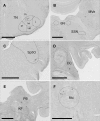
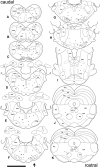

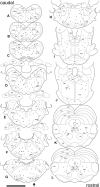
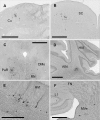

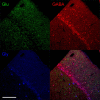
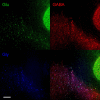


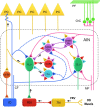
Similar articles
-
Neuronal premotor networks involved in eyelid responses: retrograde transneuronal tracing with rabies virus from the orbicularis oculi muscle in the rat.J Neurosci. 2002 Oct 15;22(20):8808-18. doi: 10.1523/JNEUROSCI.22-20-08808.2002. J Neurosci. 2002. PMID: 12388587 Free PMC article.
-
Connections to cerebellar cortex (Larsell's HVI) in the rabbit: a WGA-HRP study with implications for classical eyeblink conditioning.Behav Neurosci. 1995 Dec;109(6):1106-18. doi: 10.1037//0735-7044.109.6.1106. Behav Neurosci. 1995. PMID: 8748961
-
Transsynaptic tracing of conditioned eyeblink circuits in the mouse cerebellum.Neuroscience. 2012 Feb 17;203:122-34. doi: 10.1016/j.neuroscience.2011.12.017. Epub 2011 Dec 19. Neuroscience. 2012. PMID: 22198021
-
Neural circuitry and plasticity mechanisms underlying delay eyeblink conditioning.Learn Mem. 2011 Oct 3;18(10):666-77. doi: 10.1101/lm.2023011. Print 2011. Learn Mem. 2011. PMID: 21969489 Free PMC article. Review.
-
Cerebellar circuits and synaptic mechanisms involved in classical eyeblink conditioning.Trends Neurosci. 1997 Apr;20(4):177-81. doi: 10.1016/s0166-2236(96)10081-3. Trends Neurosci. 1997. PMID: 9106359 Review.
Cited by
-
A FN-MdV pathway and its role in cerebellar multimodular control of sensorimotor behavior.Nat Commun. 2020 Nov 27;11(1):6050. doi: 10.1038/s41467-020-19960-x. Nat Commun. 2020. PMID: 33247191 Free PMC article.
-
The impact of hippocampal lesions on trace-eyeblink conditioning and forebrain-cerebellar interactions.Behav Neurosci. 2015 Aug;129(4):512-22. doi: 10.1037/bne0000061. Behav Neurosci. 2015. PMID: 26214216 Free PMC article. Review.
-
Cerebellar Premotor Output Neurons Collateralize to Innervate the Cerebellar Cortex.J Comp Neurol. 2015 Oct 15;523(15):2254-71. doi: 10.1002/cne.23787. Epub 2015 May 12. J Comp Neurol. 2015. PMID: 25869188 Free PMC article.
-
Functional properties of eyelid conditioned responses and involved brain centers.Front Behav Neurosci. 2022 Dec 9;16:1057251. doi: 10.3389/fnbeh.2022.1057251. eCollection 2022. Front Behav Neurosci. 2022. PMID: 36570703 Free PMC article. Review.
-
Cerebellar contribution to the regulation of defensive states.Front Syst Neurosci. 2023 Mar 31;17:1160083. doi: 10.3389/fnsys.2023.1160083. eCollection 2023. Front Syst Neurosci. 2023. PMID: 37064160 Free PMC article. Review.
References
-
- Armstrong DM, Schild RF. An investigation of the cerebellar cortico-nuclear projections in the rat using an autoradiographic tracing method. I. Projections from the vermis. Brain Res. 1978;141:1–19. - PubMed
-
- Aston-Jones G, Card JP. Use of pseudorabies virus to delineate multisynaptic circuits in brain: opportunities and limitations. J Neurosci Methods. 2000;103:51–61. - PubMed
Publication types
MeSH terms
Grants and funding
LinkOut - more resources
Full Text Sources
